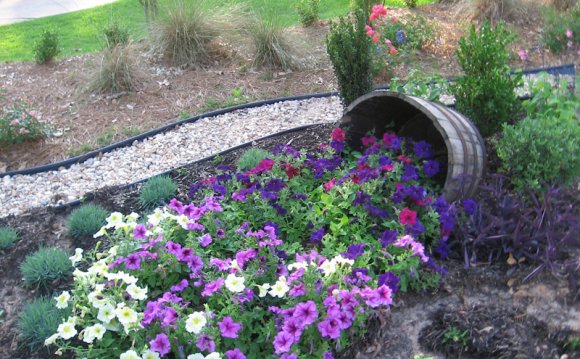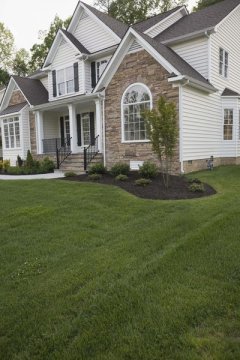
 Landscaping around a home adds value.
Landscaping around a home adds value.
Planting a landscape bed around your home's foundation creates an instant improvement to your property's look and value. When planning gardens around the foundation, take into consideration the architectural style of your home as well as how much time you have to spend on maintenance. Planting perennials will give you a relatively maintenance-free garden, while annuals will need to be replanted each year. Whatever your design, creating your landscape will require some time and muscle but once completed will be a source of pleasure year round.
Use a garden hose as a template to lay out your design. Place the hose on the ground approximately 3 feet from your home's foundation. Use the hose to create gentle curves to add visual impact to an otherwise straight border. Be sure to include a curve that will go around the corner of your home so the beds will be fluid as they extend around the foundation.
Spray a line of paint along the inside of the hose once your design is laid out. This will allow you to move the hose to continue around the house, or remove it completely so work can begin.
Place your spade on the outside of the painted line, and push down with your foot. This will cut through any sod that might be already in place and give you a clean line to work from. Remove sod from the entire bed, shaking free any dirt from the grass. If you don't have sod, dig down and shovel the soil into the center of your bed. Once the line is created, put your edging in place to create the outside line of your landscaping bed.

Add topsoil to your garden bed to give your plants a good base to grow in. Make sure all the ground is loose. Rake it smooth, keeping a raised area in the center.
Put your plants in place, with taller plants in the back one-third of the bed, medium-size plants in the center and smaller plants and ground cover in the front third. This planting strategy helps give you dimension. Keep plantings at least 6 inches from the foundation of your house to prevent water seepage and root damage. You can also plant larger bushes to highlight design elements of your home. Once your plants are in place, cover the entire bed with mulch and water well.
Things You Will Need
- Garden hose
- Spade
- Rake
- Bright color spray paint
- Edging
- Topsoil
- Mulch
- Plants
Tip
- Before doing any digging, call your local utility company or "digger's hotline" for the location of electric or gas lines. Consult your local garden center for advice on plants that will grow best in your area.















